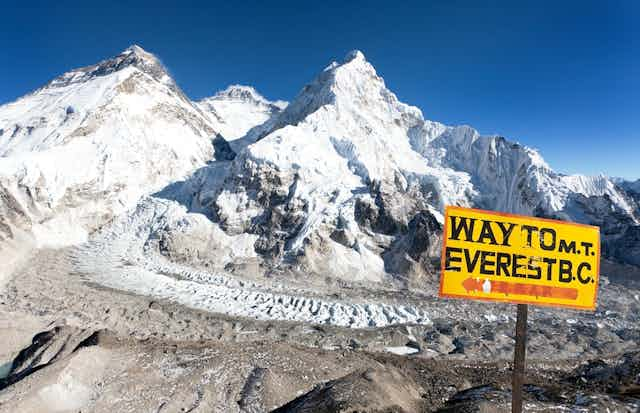Since the commercialisation of high altitude mountaineering in the 1990s, the number of climbers has increased significantly. Mount Kilimanjaro, perhaps the most popular mountaineering trip in the world, now attracts around 40,000 climbers per year. And the number attempting summits above 8,000m (such as Mount Everest) has risen exponentially.
The main challenge for all climbers is the decrease in barometric pressure and thus reduction in oxygen availability as altitude increases. The severity of altitude is defined as low (500 to 2,000m), moderate (2,000 to 3,000m), high (3,000 to 5,500m), or extreme (above 5,500m).
Remaining at high altitudes severely affects our physical capacity, cognitive function, body mass and composition, and ability to ward off illness.
If we don’t acclimatise or stagger our ascent, we’re at greater risk of acute mountain sickness, high altitude pulmonary oedema (excess fluid in the lungs) and cerebral oedema (fluid on the brain). These illnesses are all commonly characterised by symptoms such as headache, loss of appetite, nausea, weakness, light-headedness, and sleep disturbance. The presentation of these illnesses often requires retreat to lower altitudes and in severe cases, evacuation via airlift from camp.
These conditions are among the greatest obstacles to successful summit attempts, particularly when ascending quickly.
Read more: How does altitude affect the body and why does it affect people differently?
Acclimatising
Being fitter does not protect against altitude-related illness, nor does it ensure tolerance of the physiological challenges associated with high altitude exposure.
So acclimatisation is the more important factor. Acclimatisation is the process your body follows to adapt to the drop in oxygen availability. This is the best non-pharmaceutical strategy to prevent altitude sickness.
Mountaineers and trekkers can achieve acclimatisation by staying at moderate altitude (2,000-3,000m) for a few extra nights, then implementing a staggered ascent to higher altitudes. Gains in altitude should be between 300 and 600m of vertical elevation per day.
While many commercial trek schedules include rest days and acclimatisation days, some involving less technical climbing often ascend quite quickly. Some groups will ascend Kilimanjaro in four to five days (5,895 m).
To prepare for more rapid ascents, mountaineers may include some pre-trek acclimatisation, using natural or artificial environments to encourage their bodies to adapt.
Acclimatisation using artificial environments is known as “acclimation”. It can be achieved by either hypobaric hypoxia (normal oxygen concentration, lower barometric pressure), or more commonly via normobaric hypoxia (normal barometric pressure, lower oxygen concentration) using altitude tents or environmental chambers.

Of the two approaches, hypobaric hypoxia appears to be better for acclimation, though it relies on access to a hypobaric chamber or an ability to live at moderate/high natural altitude.
Although still relying on specialised equipment and expertise, more environmental chambers available mimic normobaric hypoxia. In some instances, you can even use tent or mask systems in your own home.
Acclimatisation can also mitigate the effects high altitude will likely have on exercise performance.
Training
Although fitness is not related to incidence rates of altitude sickness, trek schedules typically require many hours of hiking, often carrying a loaded pack, over at least four to five days. When combined with the gain in elevation, this means seven to eight hours per day of hiking at a moderate intensity, often over varied terrain.
So a program of targeted training will ensure trek participants are able to meet the strenuous demands of high altitude hiking and mountaineering. Evidence suggests fitter hikers report a lower sense of effort and lower levels of fatigue during high or extreme altitude trekking.
Read more: Tall tales misrepresent the real story behind Bhutan’s high altitude tigers
Studies have also found experienced mountaineers don’t need to expend as much oxygen, which is valuable when there’s less of it available. So to further prepare for high altitude expeditions, trek participants should focus on building fitness over several months by trekking at lower altitudes and carrying loads of 20-30kg for several hours over varied terrain.
This can be extended to higher altitudes (3,000m to 4,000m) and several consecutive days and weeks to allow for developing the strength required to tolerate the rigours of extreme mountain climbing. This is especially important as muscle mass and body fat losses occur during the expedition.
For ascents above 8,000m such as Mount Everest, the trekking company will usually have specialised training approaches. This may involve at least one year of training in which trekking time, distance and altitude are increased progressively, as summit day can take up to 20 hours. Experience in high altitude climbing and sumitting peaks between 6,000m and 8,000m is also required before attempting peaks of this altitude.
Staged ascents and considered approaches to acclimatisation are most likely to protect against altitude illness and ensure trek success. This involves using a planned approached to climbing with altitude targets allowing for acclimatisation.
Improving overall fitness and gaining mountaineering experience will prepare trekkers for the physical, psychological and technical challenges presented by high and extreme altitude adventures.

